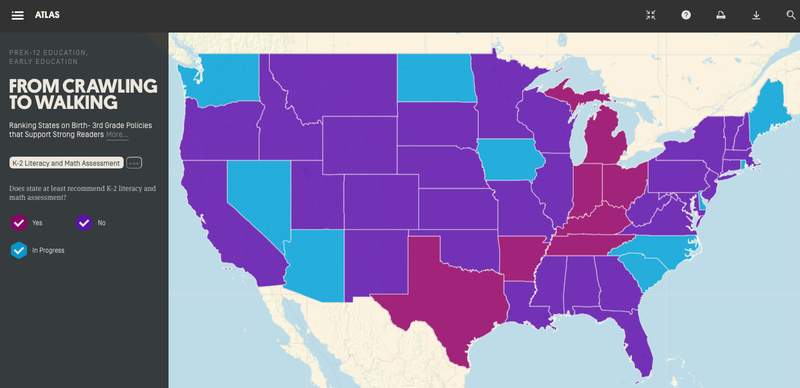Why States Need a Strategy on K-2 Literacy and Math Assessment
Blog Post

March 21, 2016
Picture Steven, a third grader in Mississippi. At the beginning of the school year, his teacher discovers that he is performing far below grade level in both reading and math. The school staff works together to provide him with multiple interventions to help him to master the grade-level standards. Despite many of the interventions that they employ and additional tutoring before- and after-school, Steven still finishes the year behind his peers. Research suggests that by failing to read on grade level by the end of third grade, Steven will be more likely to drop out of high school. Research also shows that early knowledge in math is a strong predictor of later reading skills. Had Steven’s teachers been aware of his delays in reading and math earlier and been able to intervene, he might not be in this situation.
This scenario is all too common. While all states have a clear assessment schedule beginning in third grade, this is not the case for the early grades. Fewer states have an assessment strategy for earlier grades, allowing some children to slip through the cracks. Since No Child Left Behind (recently replaced by the Every Student Succeeds Act) passed in 2001, states have been required to administer tests to all students in reading and math starting in third grade. The federal government doesn’t require the use of assessment in kindergarten through second grade, and most states do not require assessments or even provide recommendations for districts on how best to use these tools to guide instruction and intervention.
We know that gaps in achievement begin long before students enter elementary school and that they should be addressed as early as possible. Only one in ten students reading below grade level in first grade will ever catch up to their peers. And in math, some students have gaps in their early math knowledge that persists through high school. The sooner that educators can intervene, the more likely students are to succeed. Monitoring students’ developmental milestones and mastery of skills through developmental screenings, anecdotal notes, and ongoing formative assessment may assist in determining early on if children need additional classroom interventions or wraparound services, like speech-language pathology, in the early grades, which can help to ensure that students are set up for later success in academic areas like English Language Arts and math.
As a part of our From Crawling to Walking report released late last year, our team looked at whether states had implemented a state-level approach to assessment by either issuing requirements or providing recommendations for kindergarten through second grade in both math and reading assessment.
Assessment in the early grades is often a controversial topic. When some people hear the term “assessment,” they immediately conjure a picture of students sitting down to take a paper and pencil test. Early childhood assessment, however, is different. Ideally, teachers observe and take anecdotal notes describing students’ mastery level of a concept or skill over time through the use of formative multiple-domain assessments. The preponderance of anecdotal evidence displaying mastery over time shows that a child in the early grades has truly mastered a skill, which is in distinct contrast to checking for mastery through a one-time paper and pencil test. However, this type of observational assessment can be difficult to implement, particularly if educators are not provided with designated time, resources, and training. It also can be difficult if districts impose superfluous progress monitoring assessments that collect similar data.
But when formative assessment is implemented, teachers are better able to check for understanding throughout the school day and record student mastery in authentic ways without pulling children out of the classroom environment. Teachers are also able to provide students with tiered interventions as needed in the early grades because they have already captured students’ mastery of skills through detailed anecdotal notes.
States should offer clear guidance for school districts and nonpublic school early learning providers because this can help to ensure that best practices in regards to how assessment is implemented. When guidance is not provided, some districts may employ inappropriate assessment for the early grades, over-assess students, or completely fail to capture which students need additional assistance.
Our review of state assessment web pages found that 33 states do not currently provide clear assessment guidance on math and literacy assessments in kindergarten through second grade. Eleven states and Washington, D.C. are in the process of developing guidance or assessments. That leaves only seven states that currently have a K-2 assessment program or at least provide some guidance to districts on early grade assessment: Arkansas, Indiana, Kentucky, Michigan, Ohio, Tennessee, and Texas. If we need to update K-2 assessment information for your state, please let us know!

Nine states and Washington, D.C. have formed a K-3 Formative Assessment Consortium to develop a comprehensive plan for developmentally-appropriate assessment in the early grades. This consortium is funded by the U.S. Department of Education’s Enhanced Assessment Grants program and is facilitated by three research organization including BUILD, SRI International, and Child Trends.
As many states begin to review and adjust their state plans in accordance with the Every Student Succeeds Act (ESSA), they should review the plans developed by the K-3 Formative Assessment Consortium and consider developing comprehensive K-3 assessment recommendations of their own. "